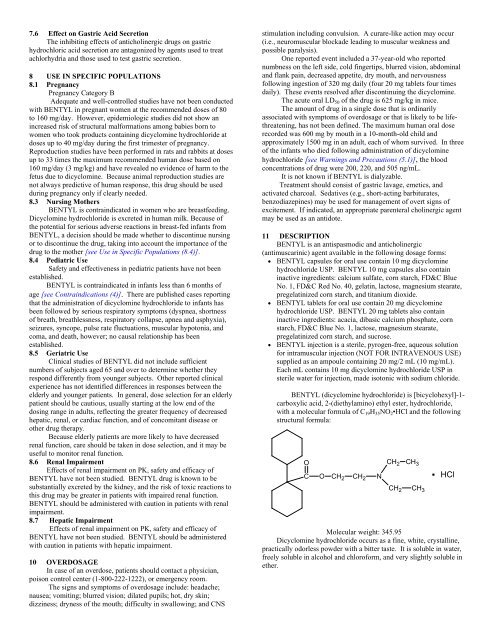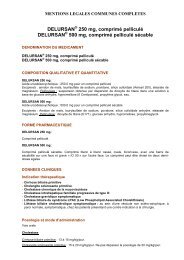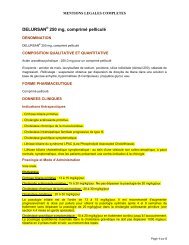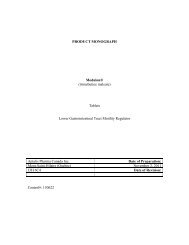bentyl - Aptalis
bentyl - Aptalis
bentyl - Aptalis
You also want an ePaper? Increase the reach of your titles
YUMPU automatically turns print PDFs into web optimized ePapers that Google loves.
7.6 Effect on Gastric Acid Secretion<br />
The inhibiting effects of anticholinergic drugs on gastric<br />
hydrochloric acid secretion are antagonized by agents used to treat<br />
achlorhydria and those used to test gastric secretion.<br />
8 USE IN SPECIFIC POPULATIONS<br />
8.1 Pregnancy<br />
Pregnancy Category B<br />
Adequate and well-controlled studies have not been conducted<br />
with BENTYL in pregnant women at the recommended doses of 80<br />
to 160 mg/day. However, epidemiologic studies did not show an<br />
increased risk of structural malformations among babies born to<br />
women who took products containing dicyclomine hydrochloride at<br />
doses up to 40 mg/day during the first trimester of pregnancy.<br />
Reproduction studies have been performed in rats and rabbits at doses<br />
up to 33 times the maximum recommended human dose based on<br />
160 mg/day (3 mg/kg) and have revealed no evidence of harm to the<br />
fetus due to dicyclomine. Because animal reproduction studies are<br />
not always predictive of human response, this drug should be used<br />
during pregnancy only if clearly needed.<br />
8.3 Nursing Mothers<br />
BENTYL is contraindicated in women who are breastfeeding.<br />
Dicyclomine hydrochloride is excreted in human milk. Because of<br />
the potential for serious adverse reactions in breast-fed infants from<br />
BENTYL, a decision should be made whether to discontinue nursing<br />
or to discontinue the drug, taking into account the importance of the<br />
drug to the mother [see Use in Specific Populations (8.4)].<br />
8.4 Pediatric Use<br />
Safety and effectiveness in pediatric patients have not been<br />
established.<br />
BENTYL is contraindicated in infants less than 6 months of<br />
age [see Contraindications (4)]. There are published cases reporting<br />
that the administration of dicyclomine hydrochloride to infants has<br />
been followed by serious respiratory symptoms (dyspnea, shortness<br />
of breath, breathlessness, respiratory collapse, apnea and asphyxia),<br />
seizures, syncope, pulse rate fluctuations, muscular hypotonia, and<br />
coma, and death, however; no causal relationship has been<br />
established.<br />
8.5 Geriatric Use<br />
Clinical studies of BENTYL did not include sufficient<br />
numbers of subjects aged 65 and over to determine whether they<br />
respond differently from younger subjects. Other reported clinical<br />
experience has not identified differences in responses between the<br />
elderly and younger patients. In general, dose selection for an elderly<br />
patient should be cautious, usually starting at the low end of the<br />
dosing range in adults, reflecting the greater frequency of decreased<br />
hepatic, renal, or cardiac function, and of concomitant disease or<br />
other drug therapy.<br />
Because elderly patients are more likely to have decreased<br />
renal function, care should be taken in dose selection, and it may be<br />
useful to monitor renal function.<br />
8.6 Renal Impairment<br />
Effects of renal impairment on PK, safety and efficacy of<br />
BENTYL have not been studied. BENTYL drug is known to be<br />
substantially excreted by the kidney, and the risk of toxic reactions to<br />
this drug may be greater in patients with impaired renal function.<br />
BENTYL should be administered with caution in patients with renal<br />
impairment.<br />
8.7 Hepatic Impairment<br />
Effects of renal impairment on PK, safety and efficacy of<br />
BENTYL have not been studied. BENTYL should be administered<br />
with caution in patients with hepatic impairment.<br />
10 OVERDOSAGE<br />
In case of an overdose, patients should contact a physician,<br />
poison control center (1-800-222-1222), or emergency room.<br />
The signs and symptoms of overdosage include: headache;<br />
nausea; vomiting; blurred vision; dilated pupils; hot, dry skin;<br />
dizziness; dryness of the mouth; difficulty in swallowing; and CNS<br />
stimulation including convulsion. A curare-like action may occur<br />
(i.e., neuromuscular blockade leading to muscular weakness and<br />
possible paralysis).<br />
One reported event included a 37-year-old who reported<br />
numbness on the left side, cold fingertips, blurred vision, abdominal<br />
and flank pain, decreased appetite, dry mouth, and nervousness<br />
following ingestion of 320 mg daily (four 20 mg tablets four times<br />
daily). These events resolved after discontinuing the dicyclomine.<br />
The acute oral LD 50 of the drug is 625 mg/kg in mice.<br />
The amount of drug in a single dose that is ordinarily<br />
associated with symptoms of overdosage or that is likely to be lifethreatening,<br />
has not been defined. The maximum human oral dose<br />
recorded was 600 mg by mouth in a 10-month-old child and<br />
approximately 1500 mg in an adult, each of whom survived. In three<br />
of the infants who died following administration of dicyclomine<br />
hydrochloride [see Warnings and Precautions (5.1)], the blood<br />
concentrations of drug were 200, 220, and 505 ng/mL.<br />
It is not known if BENTYL is dialyzable.<br />
Treatment should consist of gastric lavage, emetics, and<br />
activated charcoal. Sedatives (e.g., short-acting barbiturates,<br />
benzodiazepines) may be used for management of overt signs of<br />
excitement. If indicated, an appropriate parenteral cholinergic agent<br />
may be used as an antidote.<br />
11 DESCRIPTION<br />
BENTYL is an antispasmodic and anticholinergic<br />
(antimuscarinic) agent available in the following dosage forms:<br />
BENTYL capsules for oral use contain 10 mg dicyclomine<br />
hydrochloride USP. BENTYL 10 mg capsules also contain<br />
inactive ingredients: calcium sulfate, corn starch, FD&C Blue<br />
No. 1, FD&C Red No. 40, gelatin, lactose, magnesium stearate,<br />
pregelatinized corn starch, and titanium dioxide.<br />
BENTYL tablets for oral use contain 20 mg dicyclomine<br />
hydrochloride USP. BENTYL 20 mg tablets also contain<br />
inactive ingredients: acacia, dibasic calcium phosphate, corn<br />
starch, FD&C Blue No. 1, lactose, magnesium stearate,<br />
pregelatinized corn starch, and sucrose.<br />
BENTYL injection is a sterile, pyrogen-free, aqueous solution<br />
for intramuscular injection (NOT FOR INTRAVENOUS USE)<br />
supplied as an ampoule containing 20 mg/2 mL (10 mg/mL).<br />
Each mL contains 10 mg dicyclomine hydrochloride USP in<br />
sterile water for injection, made isotonic with sodium chloride.<br />
BENTYL (dicyclomine hydrochloride) is [bicyclohexyl]-1-<br />
carboxylic acid, 2-(diethylamino) ethyl ester, hydrochloride,<br />
with a molecular formula of C 19 H 35 NO 2 •HCl and the following<br />
structural formula:<br />
O<br />
C<br />
O CH 2 CH 2 N<br />
CH 2<br />
CH 2<br />
CH 3<br />
CH 3<br />
. HCl<br />
Molecular weight: 345.95<br />
Dicyclomine hydrochloride occurs as a fine, white, crystalline,<br />
practically odorless powder with a bitter taste. It is soluble in water,<br />
freely soluble in alcohol and chloroform, and very slightly soluble in<br />
ether.










